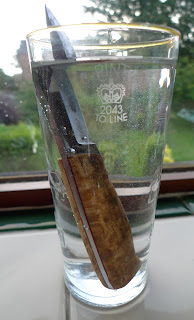A few years ago, I got an Enzo Trapper kit.
Dennis at Brisa has done a great job of getting these produced. You can buy just the blade but he also sells kits with pre-drilled handles that need only a small amount of work to fit properly.
This was one of those kits. (A little tutorial that shows the amount of work involved)
So, me being me, I went a bit unconventional and after it was glued up, rather than sanding the handle to shape, I decided to whittle the handle down a bit first. I snagged a bit of the grain and pulled a chunk out of the handle.
I cursed a little but but rather than letting it go to waste, I decided to do a little experiment - hot wax dipping the handle!
Now, hot wax dipping sheaths is quite a common thing that I've done a few times. The leather is dipped in molten beeswax repeatedly and it makes the sheath really solid and waterproof. as beeswax is used in wood polish, I thought it could be a different way to get the wax deep into the wood.
The process I went through was a series of quick dips and rubbing the excess off between dips. It went well apart from not taking into account the knife blade holding the heat and the epoxy holding the handle on softening. Part of the handle lifted a fraction so I stopped there.
That was a few years back and the knife has been used as a bit of a knockabout on odd occasions.
I came across it a few days ago and pondered over it a while.
Two thoughts were in my head:
- first off wondering how much wax was in the wood/how well it was waterproofed
 - second could I change the knife shape to something more compact. While I like the Enzo range, I do think the handle on this is a fraction too small. It's an early model and I think the handle has been changed in the newer ones.
- second could I change the knife shape to something more compact. While I like the Enzo range, I do think the handle on this is a fraction too small. It's an early model and I think the handle has been changed in the newer ones.
So first off a weigh in
then a soak in a glass of water for a few hours.
followed by a second weigh in.
A small difference - 1 gram.
Next I gave it a boiling so I could remove the handle ready for a new one.
As soon as I put the handle in the hot water, wax started bubbling out.
After a short while, I did another weigh in.
A much bigger difference so the wax must have helped hold water out!
Lots of evidence of swelling as well.
The handle was easy to remove by prising it off with another knife.
and a bit of scribbling with a Sharpie on which bits of metal to remove to make this into a compact little knife with a more universal fit of the handle.
Read More..
Dennis at Brisa has done a great job of getting these produced. You can buy just the blade but he also sells kits with pre-drilled handles that need only a small amount of work to fit properly.
This was one of those kits. (A little tutorial that shows the amount of work involved)
So, me being me, I went a bit unconventional and after it was glued up, rather than sanding the handle to shape, I decided to whittle the handle down a bit first. I snagged a bit of the grain and pulled a chunk out of the handle.
I cursed a little but but rather than letting it go to waste, I decided to do a little experiment - hot wax dipping the handle!
The process I went through was a series of quick dips and rubbing the excess off between dips. It went well apart from not taking into account the knife blade holding the heat and the epoxy holding the handle on softening. Part of the handle lifted a fraction so I stopped there.
That was a few years back and the knife has been used as a bit of a knockabout on odd occasions.
I came across it a few days ago and pondered over it a while.
Two thoughts were in my head:
- first off wondering how much wax was in the wood/how well it was waterproofed
 - second could I change the knife shape to something more compact. While I like the Enzo range, I do think the handle on this is a fraction too small. It's an early model and I think the handle has been changed in the newer ones.
- second could I change the knife shape to something more compact. While I like the Enzo range, I do think the handle on this is a fraction too small. It's an early model and I think the handle has been changed in the newer ones.So first off a weigh in
then a soak in a glass of water for a few hours.
followed by a second weigh in.
A small difference - 1 gram.
Next I gave it a boiling so I could remove the handle ready for a new one.
As soon as I put the handle in the hot water, wax started bubbling out.
After a short while, I did another weigh in.
A much bigger difference so the wax must have helped hold water out!
Lots of evidence of swelling as well.
The handle was easy to remove by prising it off with another knife.
and a bit of scribbling with a Sharpie on which bits of metal to remove to make this into a compact little knife with a more universal fit of the handle.













